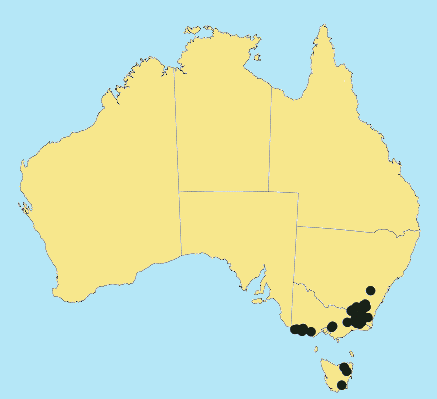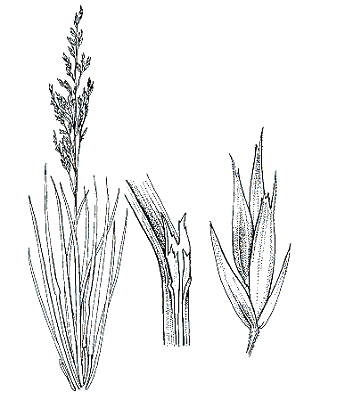Hookerochloa hookeriana (F.Muell.)
S.W.L.Jacobs. Byull. Moskovsk. Obsc. Isp. Prir. 90(5):
106–107, f. 1, 22–31 (1985).
Classification. (GPWG 2001) : Subfamily Pooideae. Tribe Poeae.
Basionym and/or
Replacement Name: Festuca
hookeriana F. Muell. ex Hook. f., Fl. Tasman. 2: 127, t. 165 (1858).
Type of Basionym or
Protologue Information: Tasmania: Cheshunt, Archer s.n..
Recent synonyms:
Austrofestuca hookeriana (F.Muell.) S.W.L.Jacobs,.
Key references
(books and floras): [1878] G.Bentham, Flora Australiensis 7 (656 as Schedonorus
hookerianus), [2002] D.Sharp & B.K.Simon, AusGrass, Grasses of
Australia (as Austrofestuca hookeriana), [2008] S.W.L.Jacobs,
R.D.B.Walley & D.J.B.Wheeler, Grasses of New South Wales (277),
[2009] A.Wilson (ed.). Flora of Australia, Vol 44A. Poaceae 2
(276 as Austrofestuca hookeriana).
Illustrations:
[2008] S.W.L.Jacobs, R.D.B.Whalley & D.J.B.Wheeler, Grasses of New South
Wales, 4th edn (277), [2009]. A.Wilson (ed.), Flora of Australia 44A:
Poaceae 2 (273, Fig.36 as Austrofestuca hookeriana).
Derivation: L.
-ana, indicating connection. As for hookeri, usually in honor of
Joseph Dalton Hooker (1817–1911), English botanist, traveller and Garden's
Director.
Habit.
Perennial. Culms erect, 55–185 cm tall, 2–3 -noded. Mid-culm nodes glabrous.
Leaf-sheath auricles absent, or present. Ligule an eciliate membrane, 2–6.8 mm
long, abaxially hairy, obtuse. Leaf-blades flat or conduplicate, 5–76 cm long,
2–6.8 mm wide. Leaf-blade surface scaberulous or scabrous.
Inflorescence.
Inflorescence compound, a panicle. Panicle ovate, effuse, 18–34.5 cm long.
Spikelets.
Spikelets pedicelled. Fertile spikelets many flowered, with at least 2 fertile
florets (4–5), comprising 4–5 fertile floret(s), with diminished florets at the
apex, oblong, laterally compressed, 7.7–14 mm long.
Glumes. Glumes
similar, similar to fertile lemma in texture. Lower glume linear, coriaceous,
keeled, 1-keeled, 2–3 -nerved. Upper glume lanceolate, 5.5–9.4 mm long,
coriaceous, keeled, 1-keeled, 3–5 -nerved. Upper glume surface asperulous.
Florets.
Fertile lemma 5.5–10.2 mm long, keeled, 5–11 -nerved. Lemma apex entire or
dentate, awned, 1 -awned. Median (principal) awn subapical, 0.5–3 mm long
overall. Palea apex dentate. Lodicules present. Anthers 3.
Continental
Distribution: Australasia.
Australian
Distribution: New South Wales, Victoria, Tasmania,
A.C.T.
New South Wales: Central Tablelands,
Southern Tablelands. Victoria: East
Gippsland, Eastern Highlands, Gippsland Plain,
Otway Plain, Snowfields, Volcanic Plain, Wannon. Tasmania:
Central Highlands,
Ben Lomond, East Coast.
Notes.
Endemic. In SE Australia, from the central
tablelands of N.S.W. S from Bundanoon, the A.C.T., Vic. amd Tas. From near
sea-level to subalpine-alpine areas, often in open, wet (e.g. swampy, boggy,
waterlogged) sites of eucalypt woodlands/forests. Flowers Nov.-Mar. Fruits
Feb.-Apr.



